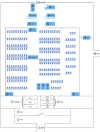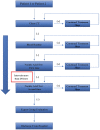The application of Temporary Ark Hospitals in controlling COVID-19 spread: The experiences of one Temporary Ark Hospital, Wuhan, China
- PMID: 32343419
- PMCID: PMC7267641
- DOI: 10.1002/jmv.25947
The application of Temporary Ark Hospitals in controlling COVID-19 spread: The experiences of one Temporary Ark Hospital, Wuhan, China
Abstract
Coronavirus disease 2019 (COVID-19) had its evolution in Wuhan, Hubei Province, China, and now it has spread around the world, resulting in a large number of deaths. Temporary Ark hospitals (TAHs) have played an important role in controlling the spread of the epidemic in the city of Wuhan. Taking one TAH with 800 beds as an example, we summarized details of the layout, setting, working mode of medical staff, patient management, admission standards, discharge standards, and standards for transferring to another hospital, hospital operation, and so on. Over the period of operation, a total of 1124 patients were admitted for treatment. Of these, 833 patients were cured and discharged from the hospital and 291 patients were transferred to other designated hospitals, owing to aggravation of their condition. The achievement was to have zero infection for medical staff, zero in-hospital deaths among admitted patients, and zero readmission for discharged patients. The rapid deployment of TAH provided a suitable place for treating mild/moderate or no asymptomatic COVID-19 patients, which successfully helped to control the infection in Wuhan. The successful model of TAH would rapidly and effectively control the spread of COVID-19 in other cities.
Keywords: COVID-19; Temporary Ark Hospital; Wuhan; control.
© 2020 Wiley Periodicals, Inc.
Conflict of interest statement
The authors declare that there are no conflict of interests.
Figures





References
-
- Wu Z, McGoogan JM. Characteristics of and important lessons from the coronavirus disease 2019 (COVID‐19) outbreak in China: summary of a report of 72 314 cases from the Chinese Center for Disease Control and Prevention. JAMA. 2020;323:1239‐1242. - PubMed
Publication types
MeSH terms
Grants and funding
- TFZZ2018017/Innovation Project of Medical School of Wuhan University/International
- 81870067/National Natural Science Foundation of China/International
- 81972408/National Natural Science Foundation of China/International
- 2018060401011321/Application and Basic Research Project of Wuhan City/International
LinkOut - more resources
Full Text Sources
Medical
Research Materials

